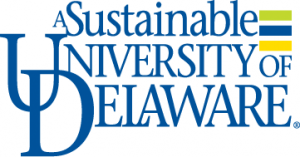Delaware Environmental Institute
Carbon chemistry in permafrost environments under changing climate
Faculty Mentor: Donald L. Sparks
Graduate Student Mentor: Tyler D. Sowers
Professional Staff Mentor: Elizabeth K. Coward
Research Description:
Soils contain more carbon (C) than the atmosphere and above-ground vegetation combined. C mobilization to the atmosphere may promote climate change and subsequent devastating environmental impacts, such as sea level rise and ocean acidification. Permafrost soils are a major component of soil C (approximately 35%). However, the response of this pool to increasing global temperatures is unknown, making investigation of the biogeochemical environmental processes impacting this pool vital to making predictions regarding potentially catastrophic climate change effects. We aim to employ a host of advanced experiments and techniques to elucidate the stability and transport of C in this pool as permafrost undergoes warming and/or fluctuating redox conditions. Students working on this project would be a component of a multi-institutional project using permafrost collected from the Fairbanks Permafrost Tunnel in Alaska, operated by the US Army Corp of Engineers, and specific project goals will be formed to cater to students’ interests.
Research Questions:
How do unique soil chemical and physical properties correlate to C sequestered in permafrost?
- What is the stability of carbon in permafrost when thawed and equilibrated at increasing temperature and/or fluctuating redox conditions?
- What types of carbon are preferentially sequestered or released from permafrost in changing temperature and/or redox environments?
Student Learning Objectives: Professional and Research Skills
This internship focuses on the development of the following professional and scientific skills.
|
Broad Professional Skills |
Specific Skills |
|
Planning and time management |
Ability to set and complete specific goals of varying scope |
|
Work independently |
Independent work ethic – work independently to problem-solve |
|
Collaborative skills |
Learning to complete tasks efficiently and effectively with others |
|
Express ideas in writing and verbally |
Communicate with diverse audiences – Development of impactful poster and oral presentations. Honing ability to deliver scientific results/impacts to people of interdisciplinary background. |
|
Broad Scientific Research Skills |
Specific Skills |
|
Understand scientific terms |
Mechanistic and applied concepts regarding sorption and redox chemistry |
|
Literature analysis |
Ability to effectively find and utilize scientific manuscripts related to environmental chemistry |
|
Use scientific tools |
X-ray absorption spectroscopy, Infrared spectroscopy, scanning electron microscopy, and additional advanced physical and chemical techniques |
|
Recognize simple patterns in research data |
Applying soil environmental chemistry concepts to qualitative and quantitative data. |
|
Apply research tools and techniques in research experiments |
Selective extractions, sorption reactivity experiments, redox experiments, etc. to investigate organo-mineral relationships. |
|
Analyze research data |
MATLAB, R, Excel, Plotly, Origin, and instrument-specific software utilization to form effective figures and tables. |
|
Understand, apply, and explain scientific concepts and theories |
Freedom to form questions and plan methods for addressing challenges. Learning to effectively communicate results through oral presentations and manuscript writing. |
Prerequisites:
Introductory experience with chemistry.
Work Environment and Expectations:
Laboratory environment: Harker ISE Lab 4thfloor. Hours are flexibly determined between student and mentor. Students will work part time during the fall and spring semesters, and full time during UD Winter Session, January 7-February 8, 2019. Students will also participate in a retreat, communications workshop and end of internship spring symposium.


